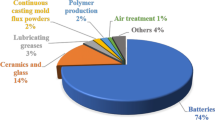Abstract
The purpose of the present study is to investigate the extraction of lithium from southern Tunisian brines. Density and concentration of Lithium in those brines were reported. Also, pondered rates of Lithium and the major elements in brines were investigated. Obtained results indicate that Lithium exist in those brines as traces. The optimization of certain parameters is required in this study. To extract Lithium from natural brines two steps were investigated. Firstly, we have used Ammonium Oxalate ((NH4)2(C2O4)⋅2H2O) to precipitate only Magnesium ion: in this procedure, three parameters were investigated (Mg/Oxalate, T (°C) and tstirring). The maximum values were found to be Mg/Ox = 0.66, T = Treflux = 100°C and tstirring ≥ 30 min. Secondly, we have used Aluminum Chloride (AlCl3⋅6H2O) in order to adsorbing lithium ions by Aluminum hydroxide. In this procedure, four parameters were investigated (pH, Al/Li, tstirring and T (°C)). Maximum values of these parameters are 7.2, 4.7, 3 h and 25°C respectively. Finally, to separate Lithium from Aluminum solution, we have used an exchange ion resin. This solution including two ions under cationic form (Al3+ and Li+). Al3+ was complexed into [Al(C2O4)3]3– using Ammonium Oxalate ions (\({{{\text{C}}}_{{\text{2}}}}{\text{O}}_{4}^{{2 - }}\)) and removed from solution using an anion exchange resin (Amberlite IRA-402). Thus, a theoretical study was carried out to determine the appropriate pH for separation. After Aluminum ions complexation by ammonium oxalate, Ox/Al molar ratio and pH was studied. Optimal values of these parameters are 3 and 4 respectively and the recovery of Li+ is set to be 98.5%.



Similar content being viewed by others
REFERENCES
Diouf, B. and Pode, R., Potential of lithium-ion batteries in renewable energy, Renewable Energy, 2015, vol. 76, pp. 375–380. https://doi.org/10.1016/j.renene.2014.11.058
Lemaire, J., Svecova, L., Lagallarde, F., Laucournet, R., and Thivel, P.X., Lithium recovery from aqueous solution by sorption/desorption, Hydrometallurgy, 2014, vol. 143, pp. 1–11. https://doi.org/10.1016/j.hydromet.2013.11.006
David, R.E., Aniruddha, J., and Edwin, R., Phase field kinetics of lithium electrodeposits, J. Power Sources, 2014, vol. 272, pp. 581–594. https://doi.org/10.1016/j.jpowsour.2014.08.062
Lin, F., Xu, X.P, Miao, S., Zheng, W.D., Shu, J., Hui, L., Xu, L.X., Chen, L.L., and Ren, Y.L., The potential dependent electrochemical impedance spectroscopy and lithium diffusion kinetics of LiFePO4, Solid State Ionics, 2014, vol. 265, pp. 49–54. https://doi.org/10.1016/j.ssi.2014.06.022
Pratima, M. and Pandey, B.D., Extraction of lithium from primary and secondary sources by pretreatment, leaching and separation: A comprehensive review, Hydrometallurgy, 2014, vol. 150, pp. 192–208. https://doi.org/10.1016/j.hydromet.2014.10.012
Sun, J.Z., Dong, Y., and Kong, C.Y., Manufacture of sodium-free lithium chloride from salt lake brine, Sep. Purif. Technol., 2014, vol. 136, pp. 309–313. https://doi.org/10.1016/j.seppur.2014.09.017
James, R.H. and Palmer, M.R., The lithium isotope composition of international rock standards, Chem. Geol., 2000, vol. 166, pp. 319–326. https://doi.org/10.1016/S0009-2541(99)00217-X
Davidson, C.F., Recovery of Lithium from Clay by Selective Chlorination, Report of Investigations 8523, Washington, D.C.: U.S. Dept. of the Interior, Bureau of Mines, 1981.
May, J.T., Witkowsky, D.S., and Seidel, D.C., Extracting Lithium from Clays by Roast-Leach Treatment, Report of Investigations 1980, Washington, D.C.: U.S. Dept. of the Interior, Bureau of Mines, 1980.
Rezza, I., Salinas, E., Calvente, V., Benuzzi, D., and Tosetti, M.I., Extraction of lithium from spodumene by bioleaching, Lett. Appl. Microbiol., 1997, vol. 25, pp. 172–176. https://doi.org/10.1046/j.1472-765X.1997.00199.x
Marcinčaková, R., Kaduková, J., Mražíková, A., Velgosová, O., and Vojtko, M., Lithium bioleaching from lepidolite using the yeast Rhodotorula rubra, Inz. Miner., 2015, vol. 16, no. 1, pp. 1–6. https://www.researchgate.net/publication/282951310
Abe, M. and Chitrakar, R., Synthetic inorganic ion-exchange materials. XLV. Recovery of lithium from seawater and hydrothermal water by titanium(IV) antimonate cation exchanger, Hydrometallurgy, 1987, vol. 19, no. 1, pp. 117–128. https://doi.org/10.1016/0304-386X(87)90045-4
Epstein, J.A., Feist, E.M., Zmora, J., and Marcus, Y., Extraction of lithium from the Dead Sea, Hydrometallurgy, 1981, vol. 6, pp. 269–275. https://doi.org/10.1016/0304-386X(81)90044-X
Kaplan, D., Process for the extraction of lithium from Dead Sea solutions, Isr. J. Chem., 1963, vol. 1, pp. 115–120. https://doi.org/10.1002/ijch.196300021
Ebensperger, A., Maxwell, P., and Moscoso, C., The lithium industry: Its recent evolution and future prospects, Resour. Policy, 2005, vol. 30, no. 3, pp. 218–231. https://doi.org/10.1016/j.resourpol.2005.09.001
Risacher, F., Alonso, H., and Salazar, C., The origin of brines and salts in Chilean salars: A hydrochemical review, Earth-Sci. Rev., 2003, vol. 63, pp. 249–293. https://doi.org/10.1016/S0012-8252(03)00037-0
Zhao, X., Zhang, Q., Wu, H., Hao, X., Wang, L., and Huang, X., Extraction of lithium from salt lake brine, Prog. Chem., 2017, vol. 29, pp. 796–808. https://doi.org/10.7536/PC170313
Somrani, A., Hamzaoui, A.H., and Pontie, M., Study on lithium separation from salt lake brines by nanofiltration (NF) and low pressure reverse osmosis (LPRO), Desalination, 2013, vol. 317, pp. 184–192. https://doi.org/10.1016/j.desal.2013.03.009
Büchel, K.H., Moretto, H.H., and Woditsch, P., Industrial Inorganic Chemistry: Second, Completely Revised Edition, New York: Wiley-VCH, 2000.
Perrin, R. and Scharff, J.-P., Chimie industrielle, Paris: DUNOD, 1999, 2nd ed., pp. 213–215.
Peiró, L.T, Méndez, G.V., and Ayres, R.U., Lithium: Sources, production, uses, and recovery outlook, JOM, 2013, vol. 65, pp. 986–996. https://doi.org/10.1007/s11837-013-0666-4
Rapport sur les essais préliminaires et “bench scale” avec la saumure de Zarzis “Sulmag/ONM 1982.”
Hamzaoui, A.H., M’Nif, A., and Rokbani, R., Mineral salts removal and lithium traces determination in highly concentrated solutions and natural brines, Talanta, 2006, vol. 70, pp. 847–851. https://doi.org/10.1016/j.talanta.2006.02.011
Hamzaoui, A.H., M’Nif, A., Hammi, H., and Rokbani, R., Contribution to the lithium recovery from brine, Desalination, 2003, vol. 158, pp. 221–224. https://doi.org/10.1016/S0011-9164(03)00455-7
Hamzaoui, A.H., Jamoussi, B., and M’Nif, A., Lithium recovery from highly concentrated solutions: Response surface methodology (RSM) process parameters optimization, Hydrometallurgy, 2008, vol. 90, pp. 1–7. https://doi.org/10.1016/j.hydromet.2007.09.005
Hamzaoui, A.H, Hammi, H., M’Nif, A., Operating conditions for lithium recovery from natural brines, Russ. J. Inorg. Chem., 2007, vol. 52, pp. 1859–1863. https://doi.org/10.1134/S0036023607120091
Author information
Authors and Affiliations
Corresponding author
Ethics declarations
The authors declare that they have no conflicts of interest.
Rights and permissions
About this article
Cite this article
Somrani, A., Mohamed, Z., Hamzaoui, A.H. et al. Study on Lithium Extraction from Salt Lake Brines. Theor Found Chem Eng 56, 1153–1157 (2022). https://doi.org/10.1134/S0040579522060252
Received:
Revised:
Accepted:
Published:
Issue Date:
DOI: https://doi.org/10.1134/S0040579522060252




